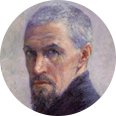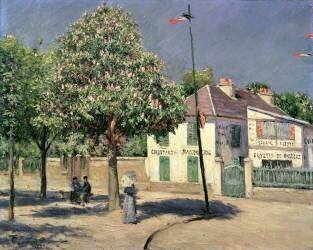Gustave Caillebotte canvas prints & artprints
A renowned painter and collector, Gustave Caillebotte profoundly changed the art world of the late 19th century with his exceptionally precise paintings, but also with his unwavering support for the Impressionist movement, via his impressive collection of works, and thanks to which a page in art history was built.
Discover the works of the most famous collector of Impressionist paintings of his time, with the oil on canvas "Les Raboteurs de parquet" (1875 - Musée d'Orsay), a painting with a plunging perspective produced in his youth, "Bateau au mouillage sur la Seine, à Argenteuil" (1891 - Nelson-Atkins Museum of Art), an oil on canvas depicting a boat in Argenteuil, a work representative of his passion for sailing and water sports, "Jeune homme au piano" (1876 - Musée Artizon de Tokyo), a portrait of his brother who followed him both in the arts and in his various passions, or "Iris bleus, jardin du Petit Gennevilliers" (1892 - Art Gallery of Ontario), a work demonstrating his passion for horticulture and produced at his property in Petit Gennevilliers, the place where he had his house built, in which he moved from 1881.
Give yourself a page from art history with a reproduction of Gustave Caillebotte available in the catalogue, to enjoy an exceptional work, a pure product of the Impressionist movement at the end of the 19th century, and discover his biography.
Biography of Gustave Caillebotte
The childhood and artistic beginnings of Gustave Caillebotte
Born in 1848 in Paris, Gustave Caillebotte was born into a wealthy family, his father, Martial Caillebotte, having made his fortune selling sheets and blankets for Napoleon's army. With his family, and in particular his brother Martial (born during 1853), the Caillebottes settled in their house in Yerres, part of a vast estate acquired by their father in 1860.
Having obtained a law degree in 1870, Gustave Caillebotte was mobilised for a few months for the defence of Paris during the Franco-Prussian war, before returning to civilian life and joining Léon Bonnat's studio, which prepared him for the Beaux-Arts competition. After a trip to Naples to perfect his technique, Caillebotte returned to the Beaux-Arts, where he met Claude Monet, with whom he remained friends throughout his career.
In 1874, Gustave Caillebotte's father died, leaving his family a colossal inheritance, including the house in Yerres, protecting them from any material needs. Gustave Caillebotte's work would also frequently illustrate the decor of the Yerres estate, with these paintings representative of his youth still to be found today in the greatest museums and private collections around the world, such as the Musée d'Orsay or the Milwaukee Art Museum.
The refusal of the Salon Officiel, and Gustave Caillebotte's commitment to Impressionism
It was in 1875 that Caillebotte's career was to change. Wishing to submit his painting "Les Raboteurs de parquet" (1875 - Musée d'Orsay) to the Paris Salon de Peinture et de Sculpture, and despite a definite talent for realism, the subject evoking an everyday scene caused the canvas to be turned down for this exhibition.
Wounded by the rejection of his work, Gustave Caillebotte moved away from the Paris Salon, which was too conventional and conservative, to become closer to the Impressionists, whom he had met through Claude Monet and Edgar Degas, whom he had met a few years earlier. He therefore exhibited several paintings from 1876, at the second Impressionist exhibition, including the oil on canvas "Les Raboteurs de parquet", as well as a depiction of his brother Martial playing the piano, and thus exhibited alongside works by Renoir, Sisley, Monet, Pissarro and Degas.
Believing in Impressionism and the great freedom this movement allowed artists, Caillebotte produced a large number of paintings and continued to exhibit alongside them until 1882. He even financed the exhibitions out of his own pocket, starting with the third Impressionist exhibition, and supported the movement by starting a collection of paintings enabling a large number of painters to subsist and continue their work.
Gustave Caillebotte the painter
First known as a talented Impressionist, Gustave Caillebotte was a recognised artist of his time, right up to the present day. His great mastery of realist painting enabled him to produce many paintings that influenced a large number of Impressionist painters, but also realists such as Edward Hopper.
Reputed for his perspectives and sense of detail in his painting, he produced work mainly around portraiture, genre scenes and still life, depicting the ordinary social customs of the time. He thus painted portraits of his friends or family on numerous occasions, notably his brother Martial or his concubine Anne-Marie Hagen, landscapes of boats, Gustave Caillebotte being passionate about boating, or depictions of everyday life in Paris, Yerres, Gennevilliers, where he settled during 1881, and the Normandy coast.
Gustave Caillebotte the Impressionist collector and patron
As well as being a talented artist, very early on, and thanks to his financial ease, Gustave Caillebotte began to support the Impressionist movement and to acquire a collection of Impressionist works on the occasion of the exhibitions in which he participated as a painter and patron.
A close friend of Monet, Pissarro and Renoir, he willingly supported them throughout their careers, buying their paintings, but also helping them to produce their canvases through the purchase of supplies and the provision of premises for them.
He completed his collection with the acquisition of many famous canvases, with, among many others, the oil on canvas "Un coin d'appartement" by Monet (1875) or the painting "Femmes à la terrasse d'un café" by Degas (1877), which he obtained discreetly by frequenting specialist art auction houses.
Passionate about Impressionism, he thus extended his collection until 1886, and the last Impressionist exhibition, and stopped it on that occasion, the neo-Impressionist movement arriving at that period being of less interest to the painter and collector.
Gustave Caillebotte and his multiple passions
Passionate about the arts, Gustave Caillebotte was nonetheless a well-to-do man who indulged in numerous passions outside artistic circles. These side activities, which are regularly represented in his work, became increasingly preponderant in his life, particularly from the mid-1880s, when he gradually stopped painting.
Among his various occupations were boating, to which he had been introduced by Alfred Sisley. After buying his first boat, and joining the Cercle de la voile de Paris, he took part in his first regattas in Argenteuil and Petit Gennevilliers, the town where he took up residence in 1881. He even went so far as to buy several boats, learn about naval architecture and enter larger regattas such as Le Havre, eventually becoming vice-president of his sailing club. This is how many of Caillebotte's paintings depicting boats on the waterways of Gennevilliers and Argenteuil can be found from the 1880s onwards, proof of his passion for boating.
It was also in his house in Gennevilliers that Gustave Caillebotte and his brother Martial developed a passion for horticulture, an activity that would accompany the siblings throughout the 1880s and 1890s, until the painter's death. The latter enlarged his land, and built a large greenhouse in which he cultivated numerous plants, including orchids, which can be seen in some of his paintings.
There was also philately, which he also practised with his brother in the 1870s, until the end of the 1880s and the resale of their collection when Martial Caillebotte married Marie Minoret in 1887.
The end of Gustave Caillebotte's life and his legacy
Installed at Le Petit Gennevilliers, and following the last Impressionist exhibition, Caillebotte no longer painted and halted his collection of Impressionist works. However, he remained close to the many artists he had worked with throughout his career, notably Renoir and Monet, whom he received on numerous occasions at his residence to discuss art, politics, horticulture or navigation.
In 1894, however, the Impressionist painter was struck by a stroke, and died prematurely at the age of 45. Pierre-Auguste Renoir, as the executor appointed by Gustave Caillebotte, would thus enforce the latter's will. Among other things, Gustave Caillebotte's will stipulated that his entire collection should be bequeathed to the French state, so that it could be exhibited to the public. Despite Renoir's determination to ensure that the entire donation was accepted by the State and that the will was respected, only 38 of the 67 paintings on offer were selected. First exhibited to the public at the Musée du Luxembourg, then at the Louvre Museum, these canvases would finally be transferred almost 100 years after the artist's death to the Musée d'Orsay, Caillebotte being considered the father of the collection offered by this place dedicated to art.
Recognised during his lifetime, having played a key role in the history of French painting, Caillebotte's work was somewhat neglected after his death, before regaining widespread popularity in the 1950s. Since then, his work has been the subject of numerous retrospectives, and has had a real influence on many artists, thanks to his work on perspective and the realism of his canvases. Although little known to the general public, Caillebotte contributed to the expansion and development of the Impressionist movement through his unwavering support for his painter friends, all of whom today rank among the greatest French artists of the period.











































